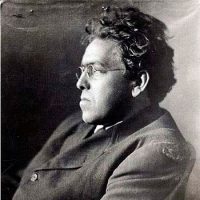

Newell Convers Wyeth was born on October 22, 1882, in Needham, Massachusetts. Growing up on a farm, he developed a deep love of nature. His mother, the daughter of Swiss immigrants, encouraged his early artistic inclinations in the face of opposition from his father, a descendant of the first Wyeth to arrive in the New World in the mid-17th century. His father encouraged a more practical use of his talents, and young Convers attended Mechanic Arts High School in Boston through May 1899, concentrating on drafting. With his mother’s support he transferred to Massachusetts Normal Art School and there instructor Richard Andrew urged him toward illustration. He studied with Eric Pape and Charles W. Reed and then painted with George L. Noyes in Annisquam, Massachusetts, during the summer of 1901.
Upon the advice of two friends, artists Clifford Ashley and Henry Peck, Wyeth decided to travel to Wilmington, Delaware, in October 1902, to join the Howard Pyle School of Art. Howard Pyle, one of the country’s most renowned illustrators, left a teaching position at Drexel Institute of Art, Science and Industry in Philadelphia to open his own school of illustration in Wilmington. Pyle was an inspired teacher and Wyeth an attentive pupil. The master emphasized the use of dramatic effects in painting and the importance of sound, personal knowledge of one’s subject, teachings Wyeth quickly assimilated and employed throughout his career. The astute young man recognized the value of Pyle’s instruction, writing to his mother just after his arrival, “the composition lecture…opened my eyes more than any talk I ever heard.” (BJW, p. 21) In less than five months, Wyeth successfully submitted a cover illustration to the Saturday Evening Post.
Following Pyle’s maxim to paint only from experience, Wyeth made three trips between 1904 and 1906 to the American West. He spent much of these trips simply absorbing the Western experience which allowed him to paint images that would place him among the top illustrators of his day. By 1907, Wyeth was heralded in Outing Magazine as “one of our greatest, if not our greatest, painter of American outdoor life.” His pictures had appeared in many of the most popular magazines of the period, such as Century, Harper’s Monthly, Ladies’ Home Journal, McClure’s, Outing, and Scribner’s.
Website
www.ncwyeth.org
[smart-photo background_color=”#ffffff” height=”40em” text_color=”#666666″ title=”true” title_expanded=”true” thumbnails_position=”bottom” transition=”fade_moveFromRight” thumb_width=”70″ thumb_height=”70″ transition_rows=”1″ slideshow_can_random=”false” tooltips=”true”]
[/smart-photo]